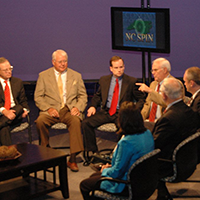NC’s fastest growing municipalities in Triangle and Brunswick
Published June 3, 2022
On Thursday, the Census Bureau released 2021 population estimates for municipalities. Here’s what the new data tell us about how North Carolina’s cities and towns have changed since the 2020 Census.
Winston-Salem passes 250K residents
Winston-Salem’s population estimate for July 1, 2021, was 250,320, an increase of 877 or 0.4% since the 2020 Census.
The next North Carolina to pass a population milestone may be Wake Forest: at 49,657 residents in 2021 and fast growth since 2020, Wake Forest should surpass 50K in the 2022 estimates.
337 municipalities have grown since 2020
Of the state’s 551 municipalities, 337 or 61% had population gains since 2020. One hundred and seventy-three—31% of all municipalities—grew faster than the state rate of 1.1%.
The fastest-growing municipalities were in the Triangle and Brunswick. Wendell (18.1%) and Zebulon (15.3%) towns, both in Wake County, were the two fastest-growing municipalities in the state. The next three fastest-growing municipalities—Navassa (11.2%), Leland (10.9%), Northwest (10.1%), and Calabash (8.6%)—were all in Brunswick County, the fastest-growing county in the state. Angier (Harnett), Sandy Creek (Brunswick), Fuquay-Varina (Wake), and Clayton (Johnston) rounded out the top ten fastest-growing places.
NC Municipal Population Change, 2020-2021
| 1 | Aberdeen town | 8,473 | 9,036 | 563 | 6.6 |
|---|---|---|---|---|---|
| 2 | Ahoskie town | 4,953 | 4,879 | -74 | -1.5 |
| 3 | Alamance village | 991 | 993 | 2 | 0.2 |
| 4 | Albemarle city | 16,416 | 16,628 | 212 | 1.3 |
| 5 | Alliance town | 724 | 729 | 5 | 0.7 |
| 6 | Andrews town | 1,662 | 1,686 | 24 | 1.4 |
| 7 | Angier town | 5,292 | 5,703 | 411 | 7.8 |
| 8 | Ansonville town | 452 | 456 | 4 | 0.9 |
| 9 | Apex town | 58,797 | 62,911 | 4,114 | 7.0 |
| 10 | Arapahoe town | 421 | 424 | 3 | 0.7 |
| 11 | Archdale city | 11,894 | 11,953 | 59 | 0.5 |
| 12 | Archer Lodge town | 4,808 | 5,034 | 226 | 4.7 |
| 13 | Asheboro city | 26,954 | 27,124 | 170 | 0.6 |
| 14 | Asheville city | 94,539 | 94,067 | -472 | -0.5 |
| 15 | Askewville town | 186 | 181 | -5 | -2.7 |
The municipalities with the largest numeric increases were more concentrated in Charlotte and the Triangle. Charlotte City gained an estimated 5,168 residents, the largest increase statewide, followed by Apex (4,114) and Fuquay-Varina (2,584) in Wake, Leland (2,547) in Brunswick, and Concord (2,511) in Cabarrus.
Fuquay-Varina, Leland, and Clayton were each among the top ten fastest-growing places and the top ten places with the largest growth.
Diverse municipalities with estimated population losses
The municipalities with the largest estimated population losses are spread across the state: Asheville (-472) had the largest estimated losses, followed by Jacksonville (-463). Both municipalities had estimated population gains during the past decade, so these estimates suggest potential changes in local growth patterns that may reflect impacts of the pandemic.
Chapel Hill and Carrboro, similarly, had strong growth over the past decade but had estimated losses between 2020 and 2021 (-198 and -131, respectively, the 8th and 12th largest losses statewide).
One-fifth of NC population lives in 5 largest places
Most of North Carolina’s incorporated places—409 or 74%--are small, containing fewer than 5,000 residents. Combined, these 409 places have just under 590,000 total residents or 6% of NC’s population.
In contrast, the five largest places—Charlotte, Raleigh, Durham, Greensboro, and Winston-Salem—each have a combined population of 2.2 million or 21% of the state’s population.
In total, 6.1 million or 58% of the state’s population lives in an incorporated place; 4.5 million or 42% lives in an unincorporated area.







